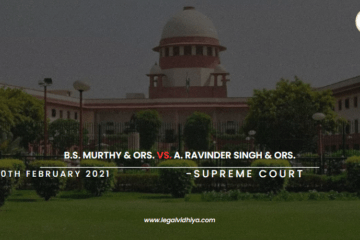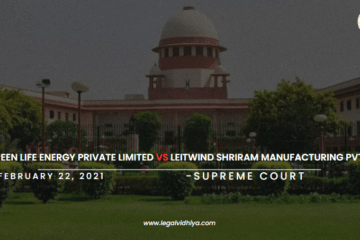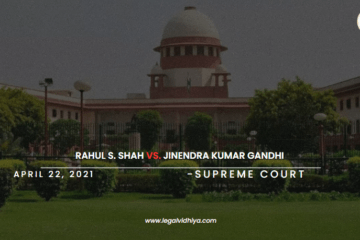Introduction
Evidence is always crucial in the decision and conclusion of a case, but the sorts of evidence might influence the choice and conclusion of a case. Direct evidence is directly related to the facts and the commission of a crime, whereas circumstantial evidence is not directly related to the facts and the commission of an offence. It is often predicated on a series of events that the prosecution can establish decisively. So, in this instance, the District and High Court made an erroneous conclusion based on circumstantial evidence, which was overturned by the Supreme Court. The Supreme Court debated several issues concerning circumstantial evidence and the burden of proof. This was a pivotal decision in law of evidence
Facts of the case[1]:
- The appellant, Rameshwar, Birdhichand Sarda, Ramvilas Rambagas Sarda, were accused 1, 2 and 3 respectively in Sessions Case No. 203 of 1982 on the file of the Additional Sessions Judge, Pune.
- The appellant and the second accused are the sons of one Birdhichand of Pune whose family has a cloth business. In addition, the appellant, a graduate in Chemical Engineering had started a chemical factory at Bhosari, a suburb of Pune.
- The third accused is the appellant’s and the second accused’s uncle. The appellant is Manjushree aka Manju’s husband, whereas the second accused is Anuradha’s husband (P.W. 35). Birdhichand’s family lives in Ravivar Peth, Pune, and owns a unit in the Takshasheela Apartments complex in the Mukund Nagar neighbourhood.
- All three accused were charged with murder by poisoning on the night of 11/12.6.1982 of Manju, the recently wedded wife of the first accused and the appellant herein, under Section 302 I.P.C. read with Section 120B. Accused No. 3 was additionally charged under Section 201 read in conjunction with Section 120B I.P.C.
- The whole case hinged on circumstantial evidence based on letters allegedly sent by the dead to some of the witnesses, as well as other statements made by the deceased to them and the medical report.
- Based on the evidence, the trial court found all three accused guilty as charged, convicted them, and sentenced the appellant to death under section 302 I.P.C. and all three accused to rigorous imprisonment for two years and a fine of Rs. 2,000 each under section 120B I.P.C. but did not award any sentence under section 201 read with section 120B.
- The appellant and the other two defendants file Criminal Appeal No. 265/83 against their convictions and penalties. The State filed a Criminal Revision motion to have the sentences of defendants 2 and 3 increased.
- The appeal and Criminal Revision application were heard together by the Division Bench of the Bombay High Court, which allowed the appellants appeal in part regarding his conviction and sentence under section 120B I.P.C. but confirmed his conviction and sentence of death awarded under section 302 I.P.C., allowed the appeal of accused 2 and 3 in full and acquitted them, and dismissed the Criminal Revision application. As a result, only the appellant has appeared before the Supreme Court after obtaining a Special Leave.
Procedural history of the case:
- IN DISTRICT SESSION COURT-
- The prosecution filed a case against the accused (sharad) and co-accused (Ramvilas and Rameshwaram, who shared a flat).
- The prosecution claimed that they conspired against the deceased and murdered her together.
- The co-accused were charged under the Indian Evidence Act of 1872 with Section 201 (causing the disappearance of evidence of offence) and Section 120-B (punishment for criminal conspiracy).
- The Session Court convicted Sharad under Section 302 of the Indian Penal Code and sentenced co-accused to two years in prison on the basis of circumstantial evidence, namely letters and post-mortem reports that showed that the death was caused by consuming poisonous (Potassium Cyanide), and the court declared the letter as a dying declaration under Section 32(1) of the Indian Evidence Act.
- IN HIGH COURT-
- The District Court forwarded the death certificate to the High Court. The accused and co-accused filed an appeal with the High Court, and the State also filed a revision for a lighter term for the co-accused on the grounds of sentence appropriateness.
- The High Court combined all three cases and acquitted Rameshwaram and Ramvilas, co-accused, but affirmed Sharad’s penalty.
Issues involved:
- The Supreme Court’s intervention under Article 161 of the Indian Constitution.
- Murder by poisoning or suicide.
- The test of the relevancy of a statement under Section 32(1)2 of the Indian Evidence Act, 1872.
- The importance of the accused’s earlier behaviour in the context of Section 83 of the Indian Evidence Act of 1872.
- The requirements for the admission of circumstantial evidence in determining whether the accused committed a crime.
- The essence and boundaries of the proximity theory.
- The application of the most recently seen theory in this circumstance.
- Is the appellant entitled to the benefit of the doubt?
Statutes involved:
1. Article 136, Constitution of India, 1950.[2]
Arguments of the Appellant:
The appellant claimed that he did not provide poison to Manju and that Manju committed herself out of frustration. The appellant advanced the following defences prove his innocence:
- As soon as he learned of his wife’s death, he summoned two physicians and followed their orders regarding sending the corpse for a post-mortem, as well as informing the police.
- Manju has highlighted the conditions in her letters that indicate she is considering suicide. The current case is not covered at all by clause (1) of Section 32 of the Indian Evidence Act. The translated letters of Manju produced by the appellant revealed that she was a very private person.
- There are several interpolations in the post-mortem report, including one relating to the location of the tongue.
- It seemed exceedingly unlikely that the appellant would murder Manju on the day before his sister’s betrothal ceremony. The betrothal ritual is extremely important in the appellant’s society. According to section 32(1) of the Indian Evidence Act, the oral evidence of five witnesses is inadmissible.
Arguments of the Respondent:
The Additional Solicitor General made the following arguments:
- The testimony of witnesses suggested that Manju was distressed, and Manju’s statement during her stay in Pune regarding the appellant’s actions towards her indicated the appellant’s motive to murder her.
- Manju was 4-6 weeks pregnant, and the appellant must have realised that killing Manju would be difficult afterwards, and that if the child was delivered, he would struggle to preserve his connection with Ujvala Kothari.
- The additional Solicitor General relied on the Supreme Court’s ruling in Deonandan Mishra v The State of Bihar[5] to argue that if the defence case is untrue, it will serve as an extra link to strengthen the prosecution case.
Bench:
- Justice SYED MURTAZA FAZALALI
- Justice A. VARADARAJAN
- Justice SABYASACHI MUKHARJI
Judgment
The accused petitioned for Special Leave under Article 136 of the Constitution. The Supreme Court determined that the prosecution had failed to prove his accusations sufficiently. The Supreme Court overturned the decisions of the High Court and District Session Court. The Supreme Court also recognised that the burden of proof is on the prosecution, not the accused, and that the court cannot set off the prosecution’s bruise. The presumption was always in favour of the accused, and the case was settled in favour of the accused, with the “Benefit of Doubt” granted to the accused. The court further stated that a conviction can only be based on circumstantial evidence if the evidence is not intrinsically less credible.
The court found that the prosecution has failed to prove its case against appellant beyond a reasonable doubt for the reasons stated above. As a result, they granted the appeal, reversed the judgements of the lower courts, and acquitted the appellant, Sharad Bridichand Sarda, of the allegations brought against him, ordering him to be freed and set free immediately.
Conclusion:
There should be adequate inspection of evidence and circumstances in criminal proceedings that result in consequences if convicted. This inspection should provide the accused a fair chance to defend his innocence. It is necessary to offer an opportunity for the accused to counter assertions of his guilt in situations based only on circumstantial evidence. Criminal activity disrupts societal calm, resulting in social and public rage and discontent. This public pressure may persuade government entities to expedite the inquiry process and bring justice as soon as possible. However, in the pursuit of swift justice, the ideals of fair trial may be jeopardised, undermining the judiciary’s mission. The current case emphasises the need of proving a complete chain of circumstantial evidence such that no notion in favour of the accused’s innocence is available. This assures fair trials and justice, bolstering trust in the courts. This is a major decision that addressed the status of circumstantial evidence in India.
[1] https://indiankanoon.org/doc/1505859/
[2] Art 136, Constitution of India, 1950
[3] Sec. 32(1), Indian Evidence Act, 1872
[4] Sec. 8, Indian Evidence Act, 1872
[5] Deonandan Mishra v State of Bihar [1955] AIR 801
This article is written by Tanaya Devadhe of ILS Law College, Pune, an intern under Legal Vidhiya





0 Comments